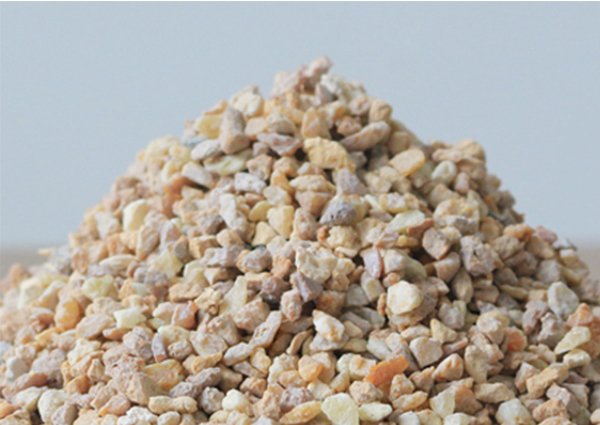
Haicheng Pai Lou town developed Mining Co., Ltd.
Address: No. 1059, Pai Lou village, Pai Lou Town, Haicheng.
Telephone:15841201000Mr. Hu
mailbox:1561481033@qq.com
Q Q:1561481033
Website:sjgrc.cn

General knowledge of magnesia
Magnesia can be divided into two categories: natural magnesia and sea magnesia, or synthetic magnesia. Natural magnesite mainly comes from natural magnesite, but it is difficult to obtain high-purity and high-quality products because of the quality constraints of raw ore. So far, seawater magnesite has become the main source of magnesite used in industrial developed countries. The theoretical content of MgO in magnesite is 47.3%. The other impurities are CaO, SiO 2 and Fe. Magnesite is decomposed by heating to 700 ~800 C in air. It is called "light burned magnesia". When further heated to 1530 C, it becomes inactive calcined magnesia and is called "dead burned magnesia". The synthetic seawater magnesia used for industrial production is made of sea water and digestion dolomite. MgO is obtained by calcining the precipitated Mg (OH) 2. The calcium-silicon ratio of magnesia used in the synthesis of unburned bricks is 0.3~0.5. The calcium-silicon ratio of high purity seawater magnesia is above 1.7, and its high temperature strength is the highest. [2]
Properties of magnesia
The main chemical composition is MgO, and the mineral composition is equiaxed brucite with density of 3.56-3.65 g/cm, Mohr hardness of 5.5, melting point of 2 800 C and evaporation at 1 800-2 400 C. Pure brucite is colorless. With the increase of Fe2O3 and CaO content, its color changes from light to dark, showing yellow, brown and black-brown. The grain size of brucite increases with the increase of calcination temperature and holding time, and the hydration resistance and slag corrosion resistance of brucite increase correspondingly.
The impurities in magnesite come from dolomite, talc, tremolite and quartz in magnesite, which makes magnesite contain SiO2, Al2O3, Fe2O3, CaO and other impurities (there are B2O3 in seawater magnesite). These impurities can reduce the high temperature strength of magnesia, and the influence degree is 1:3:11:70, if Fe2O3 is taken as 1, compared with Cr2O3, Al2O3 and B2O3. Apart from brucite, the mineral phases in magnesia can form various silicate minerals according to the CaO/SiO2 ratio, which have different effects on the properties of magnesia products (Table 1).
According to the chemical composition of magnesia, the quality and phase composition of magnesia products can be predicted. Only when the homogeneity of magnesia raw materials and the calcination temperature of magnesia raw materials are enough to make the phase composition reach equilibrium, the calculated phase composition will be consistent with the experimental results, and the higher the purity of magnesia raw materials, the more consistent.
Magnesite calcined to 700 C decomposition to discharge CO2, calcined to about 1000 C light brucite (caustic magnesium oxide), commonly known as bitter earth powder, its texture is loose, chemical activity. When the temperature continues to rise above 1700 ~ 1800 C, the periclase grains grow up gradually, the volume shrinkage, the density increases, and the chemical activity decreases greatly, that is to say, the calcined periclase becomes sintered magnesia.
The main chemical composition is MgO, and the mineral composition is equiaxed brucite with density of 3.56-3.65 g/cm, Mohr hardness of 5.5, melting point of 2 800 C and evaporation at 1 800-2 400 C. Pure brucite is colorless. With the increase of Fe2O3 and CaO content, its color changes from light to dark, showing yellow, brown and black-brown. The grain size of brucite increases with the increase of calcination temperature and holding time, and the hydration resistance and slag corrosion resistance of brucite increase correspondingly.
The impurities in magnesite come from dolomite, talc, tremolite and quartz in magnesite, which makes magnesite contain SiO2, Al2O3, Fe2O3, CaO and other impurities (there are B2O3 in seawater magnesite). These impurities can reduce the high temperature strength of magnesia, and the influence degree is 1:3:11:70, if Fe2O3 is taken as 1, compared with Cr2O3, Al2O3 and B2O3. Apart from brucite, the mineral phases in magnesia can form various silicate minerals according to the CaO/SiO2 ratio, which have different effects on the properties of magnesia products (Table 1).
According to the chemical composition of magnesia, the quality and phase composition of magnesia products can be predicted. Only when the homogeneity of magnesia raw materials and the calcination temperature of magnesia raw materials are enough to make the phase composition reach equilibrium, the calculated phase composition will be consistent with the experimental results, and the higher the purity of magnesia raw materials, the more consistent.
Magnesite calcined to 700 C decomposition to discharge CO2, calcined to about 1000 C light brucite (caustic magnesium oxide), commonly known as bitter earth powder, its texture is loose, chemical activity. When the temperature continues to rise above 1700 ~ 1800 C, the periclase grains grow up gradually, the volume shrinkage, the density increases, and the chemical activity decreases greatly, that is to say, the calcined periclase becomes sintered magnesia.
Table 1 Effect of matrix composition on properties of magnesia products
Mineral melting point or
Decomposition temperature
Influence of Mohs hardness on the properties of magnesia products
Sintering load softening temperature and compressive strength
Forsterite 18906.5 to 7 is unfavorable to raise height.
Forsterite 1498 decomposes 5 to 5.5 to promote reduction.
The difference between Mg and 1550 is smaller
Calcium silicate two CA 2130 is very small, especially when the crystal transformation is good.
Three calcium silicate, 1900 decomposition is very poor.

Haicheng Pai Lou town developed Mining Co., Ltd.
Address: No. 1059, Pai Lou village, Pai Lou Town, Haicheng.
Telephone:15841201000Mr. Hu
mailbox:1561481033@qq.com
Q Q:1561481033
Website:sjgrc.cn
Haicheng Shida Refractories Co., Ltd. Copyright All Yingkou Zhongchuang Network Technology Co., Ltd. Provides Technical Support